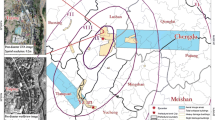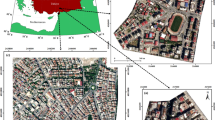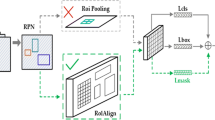Abstract
Earthquake-collapsed building identification is important in earthquake damage assessment and is evidence for map** seismic intensity. After the May 12th Wenchuan major earthquake occurred, experts from CEODE and IPSC collaborated to make a rapid earthquake damage assessment. A crucial task was to identify collapsed buildings from ADS40 images in the earthquake region. The difficulty was to differentiate collapsed buildings from concrete bridges, dry gravels, and landslide-induced rolling stones since they had a similar gray level range in the image. Based on the IPSC method, an improved automatic identification technique was developed and tested in the study area, a portion of Beichuan County. Final results showed that the technique’s accuracy was over 95%. Procedures and results of this experiment are presented in this article. Theory of this technique indicates that it could be applied to collapsed building identification caused by other disasters.
Similar content being viewed by others
References
Sakamoto M, Takasago Y, Uto K, et al. Automatic detection of damaged area of Iran earthquake by high-resolution satellite imagery. In: Proceedings of IGARSS’04. Alaska, 2004. 1418–1421
Kaya S, Curran P J, Llewellyn G. Post-earthquake building collapse: a comparison of government statistics and estimates derived from SPOT HRVIR data. Int J Remote Sens, 2005, 26: 2731–2740
Turker M, San B T. SPOT HRV data analysis for detecting earthquake-induced changes in Izmit, Turkey. Int J Remote Sens, 2003, 24: 2439–2450
Turker M, San B T. Detection of collapsed buildings caused by the 1999 Izmit, Turkey earthquake through digital analysis of post-event aerial photographs. Int J Remote Sens, 2004, 25: 4701–4714
Turker M, Emre S. Building-based damage detection due to earthquake using the watershed segmentation of the post-event aerial images. Int J Remote Sens, 2008, 29: 3073–3089
Ettarid M, Rouchdi M, Labouab L. Automatic extraction of buildings from high resolution satellite images. In: Proceedings of ISPRS’08. Bei**g, 2008, 8: 415–420
Turker M, Cetinkaya B. Automatic detection of earthquake-damaged buildings using DEMs created from pre- and post-earthquake stereo aerial photographs. Int J Remote Sens, 2005, 26: 823–832
Trianni G, Gamba P, Acqua F D, et al. Damage detection using ALOS-PALSAR images and ancillary information for the 2007 Peru earthquake. Geophys Res Abs, 2008, 10: EGU2008-A- 01201
Gamba P, Acqua F D, Trianni G. Rapid damage detection in Bam area using multitemporal SAR and exploiting ancillary data. IEEE Trans Geosci Rem Sens, 2007, 45: 1582–1589
Matsuoka M, Yamazaki F. Building damage map** of the 2003 Bam, Iran, earthquake using Envisat/ASAR intensity imagery. Earthq Spectra, 2005, 21: 8285–8294
Matsuoka M, Yamazaki F. Use of satellite SAR intensity imagery for detecting building areas damaged due to earthquakes. Earthq Spectra, 2004, 21: 975–994
Yonezawa C, Takeuchi S. Decorrelation of SAR data by urban damages caused by the 1995 Hyogoken-Nambu earthquake. Int J Remote Sens, 2001, 22: 1585–1600
Stramondo S, Bignami C, Chini M, et al. Satellite radar and optical remote sensing for earthquake damage detection: results from different case studies. Int J Remote Sens, 2006, 27: 4433–4447
Pesaresi M, Benediktsson J A. A new approach for the morphological segmentation of high-resolution satellite imagery. IEEE Trans Geosci Remote Sens, 2001, 39: 309–320
Benediktsson J A, Pesaresi M, Arnason K. Classification and feature extraction for remote sensing images from urban areas based on morphological transformations. IEEE Trans Geosci Remote Sens, 2003, 41: 1940–1949
Serra J. Image Analysis and Mathematical Morphology. New York: Academic Press, 1982
Serra J. Image Analysis and Mathematical Morphology. Vol 2. New York: Academic Press, 1988
Haralick R M, Shanmugan K, Dinstein I. Textural features for image classification. IEEE Trans Syst Man Cybern, 1973, 3: 610–621
Soille P, Pesaresi M. Advances in mathematical morphology applied to geoscience and remote sensing. IEEE Trans Geosci Remote Sens, 2002, 40: 2042–2055
Anys H, Bannari A, He D C, et al. Texture analysis for the map** of urban areas using airborne MEIS-II images. In: Proceedings of the First International Airborne Remote Sensing Conference and Exhibition, Strasbourg, 1994, 3: 231–232
Author information
Authors and Affiliations
Corresponding author
Additional information
Supported by the National Basic Research Program of China (Grant No. 2009 CB723906) and Knowledge Innovation Program of the Chinese Academy of Sciences (Grant No. KKCX1-YW-01)
About this article
Cite this article
Guo, H., Lu, L., Ma, J. et al. An improved automatic detection method for earthquake-collapsed buildings from ADS40 image. Chin. Sci. Bull. 54, 3303–3307 (2009). https://doi.org/10.1007/s11434-009-0461-3
Received:
Accepted:
Published:
Issue Date:
DOI: https://doi.org/10.1007/s11434-009-0461-3




